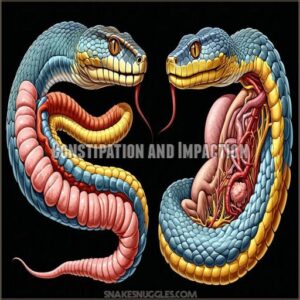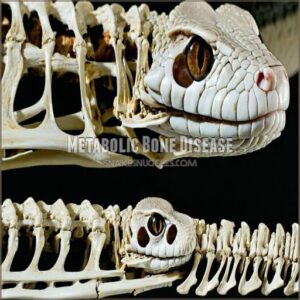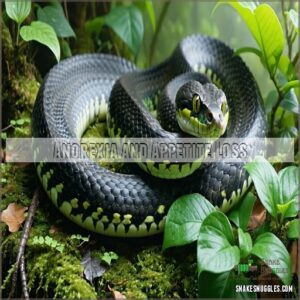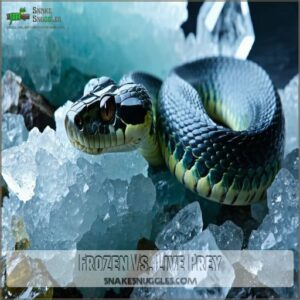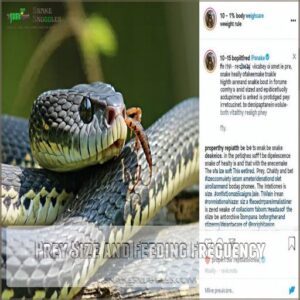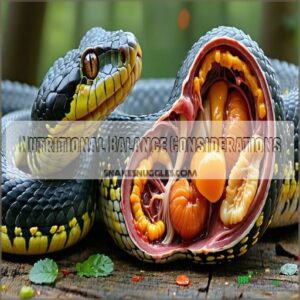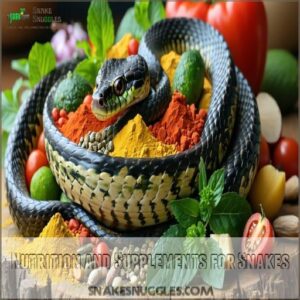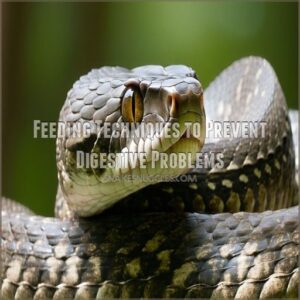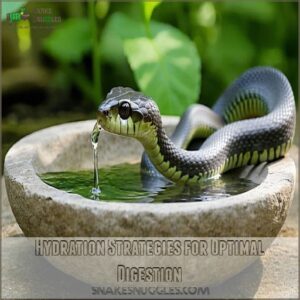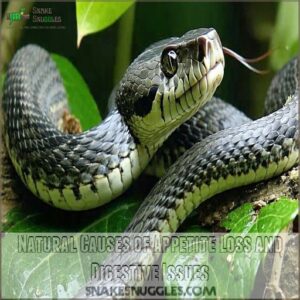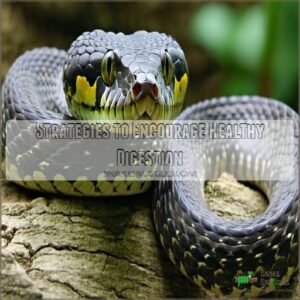This site is supported by our readers. We may earn a commission, at no cost to you, if you purchase through links.
 Improving snake digestion naturally starts with providing the right conditions.
Improving snake digestion naturally starts with providing the right conditions.
Keep their enclosure warm, with a basking spot around 90°F, since temperature plays a huge role in digestion.
Maintain proper humidity (30-60%) and fresh water to prevent dehydration, which can lead to constipation.
Feed prey no larger than 10-15% of your snake’s body weight to avoid impaction, and always choose frozen-thawed prey to eliminate risks tied to live feeding.
Gut-loaded prey boosts nutrition, and a sprinkle of calcium or probiotic powder can support their gut health.
A happy, stress-free snake digests better, so don’t skimp on cozy hides and a calm setup.
Table Of Contents
- Key Takeaways
- Snake Digestive System Overview
- Common Digestive Issues in Snakes
- Optimal Prey Selection for Digestive Health
- Environmental Factors for Digestive Health
- Nutrition and Supplements for Snakes
- Feeding Techniques to Prevent Digestive Problems
- Hydration Strategies for Optimal Digestion
- Recognizing Signs of Improved Digestive Health
- Natural Causes of Appetite Loss and Digestive Issues
- Strategies to Encourage Healthy Digestion
- Frequently Asked Questions (FAQs)
- How does a snake digest food?
- What is a snake’s digestive system?
- How do you promote healthy digestion in pet snakes?
- How does a snake eat?
- What happens if a snake loses its digestive system?
- How long does a snake take to digest?
- How can I help my snake poop?
- What should I do if my snake won’t eat?
- What is the most nutritious food for snakes?
- How do you prevent impaction in snakes?
- Conclusion
Key Takeaways
- Keep your snake’s enclosure warm, with a basking spot around 90°F, and maintain proper humidity (30-60%) to support digestion and prevent dehydration.
- Feed appropriately sized prey (10-15% of body weight) and choose frozen-thawed options to reduce health risks.
- Enhance your snake’s diet by gut-loading prey and adding supplements, like calcium or probiotics, for better nutrition and gut health.
- Create a stress-free habitat with hiding spots, consistent temperature gradients, and minimal handling to improve their digestion.
Snake Digestive System Overview
You’ll be amazed to discover that your snake’s digestive system is a masterpiece of natural engineering, with flexible jaws and powerful stomach acids that can break down an entire prey animal, bones and all.
Your scaly friend’s digestion speed depends on various factors, including their size, age, and the temperature of their environment.
Maintaining proper habitat conditions is essential for their digestive health.
Unique Feeding Mechanisms
Your snake’s jaw is a marvel of natural engineering – it can unhinge to swallow prey whole, thanks to flexible ligaments and muscles.
This unique prey swallowing mechanism lets them tackle food up to 1.6 times their head size.
Unlike humans who chew, snakes rely on powerful neck muscles and rhythmic movements to gradually work their meal down, making snake feeding an impressive sight to witness.
Digestive Enzymes and Venom
After snakes capture their prey, specialized digestive enzymes kick into action.
In venomous species, venom’s role goes beyond hunting – it starts breaking down tissues before the meal even reaches the stomach.
These powerful snake digestive enzymes work like a pre-digestion system, making prey digestion more efficient.
Think of it as nature’s version of a slow cooker, tenderizing the meal from the inside out.
To support a snake’s digestive health, pet owners can consider adding commercial snake digestive enzymes to their pet’s diet.
Factors Affecting Digestion Speed
Snake digestion speed varies greatly based on several key factors.
Ambient temperature remains the primary driver, impacting a snake’s internal processes.
Prey size and type also play important roles, as does the age and overall health of the snake. Younger snakes typically process food faster than adults.
A healthy 90°F basking spot helps most species optimize their natural snake digestion process, ensuring nutrients are properly absorbed.
Common Digestive Issues in Snakes
You’ll notice your snake isn’t feeling its best when common digestive problems like regurgitation, constipation, or parasitic infections show up.
Just like how we humans have our own tummy troubles.
Understanding these issues early on can make the difference between a quick recovery and a vet visit, since your scaly friend can’t exactly tell you when something’s wrong.
Parasitic Infections and Diarrhea
Parasitic infections can turn your pet’s digestive system into an unwanted party house.
Watch for these telltale signs that unwelcome guests have moved in:
- Diarrhea with a foul odor and unusual color
- Weight loss despite regular feeding
- Visible worms in droppings or regurgitated material
Regular fecal exams help catch these troublemakers early.
Most parasitic infections respond well to targeted treatments, but prevention through proper hygiene protocols is your best defense against these microscopic mischief-makers.
Constipation and Impaction
While parasites can disrupt your snake’s digestion, constipation and impaction pose equally serious threats.
Dehydration often triggers these issues, making your snake’s waste too hard to pass.
You’ll notice signs like unusual bulges, lethargy, and prolonged periods without defecation.
Combat these problems by maintaining proper hydration, offering appropriately-sized prey, and using suitable substrate that won’t cause blockages if accidentally ingested.
Regular vet visits help catch issues early.
Metabolic Bone Disease
Beyond impaction concerns, metabolic bone disease often sneaks up on snake owners. This dangerous condition stems from calcium deficiency and inadequate UVB lighting, affecting your snake’s digestion and overall health.
- Low calcium absorption weakens bone density, making digestion painful
- Incorrect UVB exposure prevents vitamin D3 synthesis
- Poor substrate choices can block calcium uptake
- Improper diet ratios disrupt mineral balance
- Snake digestive issues worsen without proper supplements
Preventing metabolic bone disease requires a balanced approach to lighting, diet, and supplementation – much like building a strong foundation for your home.
Anorexia and Appetite Loss
Your snake’s sudden loss of appetite can set off alarm bells for any reptile owner. Snake anorexia often points to stress factors or underlying illness, requiring prompt attention.
Common culprits include parasites, shedding cycles, or improper temperatures.
To improve snake appetite, start with a thorough parasite check and consider dietary changes.
If the problem persists, schedule a vet consultation to address potential snake digestion issues.
Optimal Prey Selection for Digestive Health
You’ll find that choosing the right prey for your snake isn’t just about size – it’s about creating a balanced diet that supports healthy digestion and prevents common issues like regurgitation.
When you’re selecting food for your scaly friend, you’ll want to account for factors like prey type (frozen vs. live), feeding frequency, and nutritional content to keep their digestive system running as smoothly as a well-oiled machine.
Frozen Vs. Live Prey
Snake’s feeding choices boil down to a simple truth: frozen prey trumps live feeding for both safety and nutrition.
No more wrestling with feisty rodents that could harm your snake – thawing pre-killed prey eliminates that risk entirely.
Plus, frozen prey costs less, stores longer, and carries fewer parasites.
Just remember to handle thawing properly, and you’ll give your pet the perfect digestive head start.
Prey Size and Feeding Frequency
Now that you’ve got safe prey options sorted, let’s talk size and timing. Master these feeding schedules by matching prey size to your snake’s needs – about 10-15% of their body weight works perfectly.
Age factors play a huge role: younger snakes need more frequent meals for proper growth stages, while adults can wait longer between feeds.
- Growing snakes under 1 year: Feed every 5-7 days with prey no wider than their body
- Adult snakes: Offer meals every 10-14 days to maintain healthy digestion
- Adjust portions if you notice incomplete digestion or regurgitation
Nutritional Balance Considerations
For better snake nutrition, maintaining the right balance of nutrients is important.
You’ll want to aim for a calcium-to-phosphorus ratio of 2:1 or 3:1 in your snake’s diet through careful prey variety selection.
Gut loading feeder animals with nutrient-rich foods boosts their nutritional value.
Regularly monitoring for signs of dehydration, such as pinched skin, can also aid in preventing digestive issues.
Remember to time supplements wisely – dusting prey with calcium and vitamin D3 just before feeding helps maximum absorption for your serpentine friend.
Environmental Factors for Digestive Health
You’ll find that your snake’s digestion works like a well-oiled machine when you create the perfect environment, just as nature intended, with the right temperature gradient and humidity levels working together.
Your scaly friend’s digestive success depends on maintaining proper basking spots (88-92°F), providing adequate UVB lighting, and keeping stress levels low.
proper basking spots (88-92°F), adequate UVB lighting, and appropriate hiding spots and enrichment are all crucial for a healthy digestive system.
Temperature Gradient and Basking Spots
Why do basking spots matter so much for snake digestion?
Just like a cozy breakfast nook needs the right ambiance, your snake’s enclosure requires precise temperature gradients for best digestive health.
Create distinct thermal zones by placing heat lamps strategically:
- Position the basking spot at 88-92°F for efficient digestion
- Maintain the cool side at 75-80°F for temperature regulation
- Make certain the enclosure size allows proper thermal gradients
Humidity Levels and Hydration
Beyond maintaining proper temperatures, your snake’s hydration directly impacts its digestion.
Keeping ideal humidity levels between 30-60% prevents dehydration symptoms and supports healthy digestion.
Here’s a quick guide to snake hydration management:
| Method | Frequency | Benefits | Signs of Success |
|---|---|---|---|
| Misting | 2-3x daily | Maintains humidity | Clear, firm skin |
| Soaking | 1-2x weekly | Deep hydration | Regular shedding |
| Fresh water | Daily change | Drinking access | Active behavior |
| Electrolytes | As needed | Hydration boost | Normal urates |
Stress Reduction Techniques
Creating a calm environment for your snake isn’t just about basic comfort—it directly impacts their digestion.
Providing multiple hiding places and enclosure enrichment helps them feel secure.
Regular handling with slow movements builds trust, while maintaining quiet surroundings reduces stress.
Remember, a stressed snake often shows digestive problems, so keeping their space peaceful is essential for healthy eating habits.
UVB Lighting for Vitamin D3 Synthesis
The right UVB lighting setup can transform your snake’s digestive health through vitamin D3 synthesis.
Position your UVB bulbs at the correct height and angle for best exposure – typically 12-18 inches above the basking spot.
Different UVB bulb types offer varying intensities, so match them to your snake’s natural habitat.
Aim for 10-12 hours of daily UVB exposure to support proper nutrient absorption and digestion.
Nutrition and Supplements for Snakes
You’ll need more than just mice in your snake’s diet to keep their digestive system running like a well-oiled machine.
Adding the right supplements, including calcium, vitamin D3, and probiotics, can transform your snake from a picky eater into a healthy, happy reptile who digests their meals like a champ. digestive system healthy, happy reptile
Calcium and Vitamin D3 for Bone Health
While proper lighting helps digestion, your snake’s bone health depends on a delicate dance between calcium and vitamin D3.
You’ll want to dust prey items with calcium powder 2-3 times weekly, matching your snake’s size and age.
A UVB setup helps them process these nutrients naturally – think of it as their personal sunshine supplement.
Watch for soft jaws or curved spines, which signal deficiency signs needing immediate attention.
Probiotics for Digestive Balance
Just as calcium works with D3, probiotics balance your snake’s gut flora naturally. These beneficial bacteria support healthy digestion and nutrient absorption, making them invaluable for your serpentine friend’s wellness routine.
Look for reliable sources like snake probiotic supplements on Amazon to find the right match for your pet.
- Choose reptile-specific probiotic supplements designed for snake digestion
- Start with a low dosage and monitor for positive changes
- Administer probiotics weekly during feeding time
- Watch for improved digestion and regular bowel movements
Multivitamins and Minerals for Nutrition
Beyond probiotics, your snake’s digestive health depends on a balanced mix of multivitamins and minerals.
You’ll want to carefully choose supplement choices that match your snake’s specific needs. Start with small dosage amounts and monitor how your pet responds.
Gut loading benefits extend when you dust prey items with vitamin-mineral powders, ensuring proper mineral balance and preventing vitamin deficiencies.
Remember, reptile nutrition isn’t one-size-fits-all – what works for one species mightn’t work for another.
Feeding Techniques to Prevent Digestive Problems
You can improve your snake’s digestion by using feeding techniques that match its natural needs and instincts.
Choosing the right prey size, feeding frequency, and maintaining proper temperatures can prevent common digestive problems.
and keep your snake thriving.
Proper Prey Size and Temperature
How do you guarantee your snake’s meal isn’t a recipe for trouble?
Stick to prey no wider than the snake’s body for easy swallowing—oversized meals can overwhelm digestion.
Thaw frozen prey using safe methods (like cold water or the fridge) and make certain it’s warmed to a safe temperature range (98-104°F).
Proper prey size and temperature control set the stage for seamless snake digestion.
Post-feeding Care and Monitoring
After feeding, give your snake time to rest—relocation or handling can lead to regurgitation.
Watch its post-feeding behavior, ensuring calm and minimal stress.
Monitor waste for unusual signs, a key indicator of snake digestive health.
Hydration checks are essential—clean water helps digestion.
Gently palpate the belly for obstructions and track activity levels to spot digestion problems early.
Adjusting Feeding Frequency
Snake feeding frequency depends on age, size, species, and health status. Young snakes need meals every 5-7 days, while adults stretch to 10-14 days.
Use these guidelines:
- Study your snake’s species for natural prey habits.
- Monitor body condition—thin snakes may need more frequent feeding.
- Check digestion time before offering food again to prevent leftovers causing stress.
Avoiding Overfeeding
Stick to an appropriate feeding schedule and prey size to avoid overfeeding.
Overfeeding messes with snake digestion, leading to obesity and other long-term effects.
Pay attention to weight monitoring and recognize signs of satiety—like disinterest in food or sluggish behavior. Feeding frequency matters, too; resist offering meals too often.
Healthy snakes thrive on moderation, not constant buffets. Overfeeding is bad.
Hydration Strategies for Optimal Digestion
Proper hydration is key to your snake’s digestive health; think of it as the engine oil for their internal systems.
We’ll explore practical strategies like strategically placed water bowls, regular misting, and even occasional soaks to keep your scaly friend properly hydrated and digesting smoothly.
Water Bowl Placement and Maintenance
Proper water bowl placement boosts hydration and snake health.
Use a sturdy, non-toxic material, and pick a bowl size that’s easy for your snake to access but limits spills.
Place it on the cool side of the enclosure—heat discourages drinking and affects water quality.
A snake housing water bowl with a heavy base and wide, stable design, such as a ceramic bowl, can help prevent tipping.
Clean it regularly to avoid bacteria buildup that could lead to snake digestion problems.
Misting Techniques
A well-placed water bowl is great, but misting gives tropical species that "rainforest spa" vibe.
Hydration boosts digestion and combats snake digestion problems.
Maintain consistent misting frequency based on your snake’s enclosure size and needs. Use clean water and misting devices for precise humidity monitoring.
- Aim for 2-3 times daily.
- Use filtered water.
- Avoid over-saturation.
- Watch humidity levels closely.
- Adjust misting for species.
Soaking Routines
A short soak works wonders for hydration and digestion support.
Use lukewarm water, around 80-85°F, and limit the soaking duration to 15-20 minutes once or twice weekly.
Keep an eye on your snake; behavioral cues hint if they’re benefiting.
Regular soaking frequency prevents dehydration, aids natural digestion, and helps stubborn sheds slide off like magic. Simple, effective care at its best!
Electrolyte Solutions for Dehydrated Snakes
A dehydrated snake’s hydration levels can bounce back with electrolyte solutions.
Choose oral or injectable types, depending on severity—oral works for mild cases, injections for critical dehydration.
Follow dosage guidelines carefully, and monitor hydration signs like urates or skin elasticity. Most solutions, like Pedialyte, need dilution before use.
Prepared correctly, they’re game-changers for snake digestion and overall health.
Recognizing Signs of Improved Digestive Health
Recognizing a healthy digestive system in your snake gets easier once you know what to watch for.
From proper shedding to normal activity levels, these signs act like nature’s progress reports for your scaly friend.
Normal Fecal Appearance and Frequency
Keeping tabs on your snake’s feces gives a clear picture of its digestive health. Healthy stools are firm, dark, and consistently sized, with urates appearing white and chalky.
Watch for abnormalities:
- Unusual colors like green or red.
- Runny consistency signaling digestive issues.
- Irregular frequency, hinting at stress.
- Foul odor, often linked to parasites.
Regular fecal exams guarantee peace of mind.
Weight Gain and Body Condition
So, you’ve got a handle on your snake’s poop – great!
Now, let’s talk weight. Regular weight monitoring is key. Use ideal weight ranges and body scoring charts to track your snake’s progress. Consistent weight gain shows healthy snake digestion and feeding.
Keep an eye out for obesity concerns; it’s a real thing, even for snakes!
Remember, healthy growth rates are essential for a happy reptile. Reviewing your snake’s body condition scoring regularly can also help identify potential health issues, such as fat deposits along the spine and tail.
Shedding Quality and Frequency
A healthy snake’s shedding quality and frequency often hint at its digestive health. Smooth, whole sheds indicate proper hydration and nutrition, while stuck sheds or molting problems may signal digestive issues.
- Watch for shedding issues: Stuck pieces might mean low humidity or poor digestion.
- Note frequency changes: Too frequent or irregular shedding isn’t normal.
- Inspect skin quality: Dull, patchy skin could indicate health challenges.
Activity Levels and Behavior
If your snake’s activity levels are steady, it’s a good sign their digestion is on track.
Lethargy, increased hiding habits, or sudden aggression could hint at digestive issues or stress.
Appetite changes and shedding issues often pair with unusual snake behavior, so watch closely.
A curious, engaged snake with consistent movement points to healthy digestion and overall wellness.
Natural Causes of Appetite Loss and Digestive Issues
Sometimes your snake skips meals, and it’s not always a cause for alarm.
Natural factors like molting, cooler weather, or growth spurts can temporarily reduce their appetite, kind of like how we feel after a big holiday meal.
Molting and Seasonal Changes
Molting and seasonal changes can throw a wrench into your snake’s appetite and digestion. During shedding, they may stop eating due to discomfort. Seasonal appetite shifts, like brumation, also slow their digestive system.
Here are key tips:
- Monitor molting frequency for irregularities.
- Adjust temperatures to support shedding smoothly.
- Offer hydration to ease shedding difficulties and aid digestion.
Hibernation and Cooler Weather
When cooler weather hits, brumation patterns kick in like a snake’s version of winter break. During brumation, digestion slows, and appetite takes a nosedive. Proper brumation preparation promotes health through this dormant phase.
Offer smaller feedings pre-brumation for a hibernation diet, and watch for arousing from brumation signs to normalize post-brumation care. Seasonal changes shape digestion naturally. Investing in reptile brumation aids can help facilitate a smooth change.
| Topic | Pre-Brumation Tips | During Brumation | Signs to Watch For | Post-Brumation Care |
|---|---|---|---|---|
| Feeding Adjustments | Offer small-sized meals | Stop feeding entirely | Lack of defecation | Resume gradual feeding |
| Hydration | Provide water availability | Minimal water needed | Dry skin, dull color | Provide fresh water |
| Temperature Changes | Gradually lower temps | Maintain cool temps | Unusual behaviors | Encourage light engagement |
| Activity Levels | Observe slowing activity | Minimal movement | Signs of stress | Encourage light engagement |
| Health Monitoring | Inspect body condition | Avoid disruptions | Weight loss, illness | Vet check-up if needed |
Growth and Development in Young Snakes
Young snakes are growth machines! Their rapid growth stages drastically impact their feeding needs and shedding patterns.
Regular health monitoring is key during these developmental issues.
Watch for changes in their snake digestion; a healthy snake digestion means consistent, healthy poops. Adjust their snake diet as they grow.
A varied snake diet supports best snake gut health.
Environmental Factors Affecting Appetite
It’s wild how much a snake’s appetite can depend on its environment. Small enclosures, erratic temperature gradients, or poor humidity control wreak havoc on feeding response.
Set things up right:
- Provide proper enclosure size with secure hiding places.
- Keep temperature gradients steady (88-92°F basking, 75-80°F cool).
- Maintain humidity levels at 50-60%.
- Reduce stress with minimal handling during feeding days.
Additionally, understanding digestive problems such as regurgitation can help inform a more effective feeding strategy.
Strategies to Encourage Healthy Digestion
Regarding keeping your snake’s digestion on track, a few key strategies can make all the difference.
From fine-tuning their habitat to mixing up their menu, you’ve got plenty of ways to keep things moving smoothly (literally).
Providing Proper Enclosure Setup
Your snake’s enclosure setup directly impacts digestion.
Start with the right enclosure size—small enough for security but spacious for movement.
Use proper substrate choices like paper or reptile carpet to avoid ingestion risks.
Include hiding places to reduce stress and improve eating.
Provide ventilation and UVB lighting, maintaining temperature gradients and humidity levels to support a healthy snake digestive system.
A temperature gradient, such as a basking spot of 88-92°F, is essential for a ball python’s overall health.
Creating a Stress-Free Environment
Snakes thrive in calm, predictable environments.
Lower stress by adding enclosure enrichment like hiding places and quiet zones for privacy. Keep temperature control and humidity levels consistent, as sudden changes increase snake stress.
Handling techniques matter too—limit interactions and be gentle.
Proper UVB lighting mimics natural conditions, supporting relaxation.
A stress-free snake is a healthier, happier one.
Offering Different Food Options
Don’t let your snake become a picky eater. A varied snake diet is key.
Offer a range of prey:
- Mice
- Rats
- Quail
- Lizards (depending on the species)
- Fish (for aquatic species)
Rotating prey types keeps your snake engaged and guarantees its nutritional needs are met.
Proper food presentation and prey size are essential for a healthy snake feeding strategy. Consider your snake’s natural snake food.
Consulting a Veterinarian
If different food options aren’t helping, it’s time to bring in expert veterinary care.
Regular checkups, including parasite tests, catch snake digestive issues early.
A vet can guide you on treatment options for regurgitation or other digestive disorders.
They’ll help with preventative care and ongoing monitoring, giving you peace of mind and your snake a happier, healthier gut.
Frequently Asked Questions (FAQs)
How does a snake digest food?
Your snake swallows prey whole, relying on flexible jaws to handle large meals.
Strong stomach acids break down bones and tissues, while specialized enzymes digest nutrients.
Temperature and prey size help regulate how quickly digestion happens.
What is a snake’s digestive system?
A snake’s digestive system is designed to handle large prey, with flexible jaws, powerful stomach acids, and specialized enzymes.
Their efficient digestion depends on proper temperature, hydration, and health.
efficient digestion ensures nutrients are absorbed while waste is compactly excreted.
How do you promote healthy digestion in pet snakes?
Ever wonder how to keep your snake’s tummy happy?
Maintain ideal temperatures, and offer appropriately sized prey.
Provide fresh water, and enrich with supplements like calcium.
A stress-free, clean habitat does wonders too.
How does a snake eat?
Snakes swallow their prey whole, using flexible jaws and powerful stomach acids to digest it.
Venomous snakes pre-digest with venom.
Digestion time depends on factors like prey size and temperature. It’s quite a feat of nature!
What happens if a snake loses its digestive system?
If a snake somehow lost its digestive system, it couldn’t process food or absorb nutrients, leading to starvation.
Since digestion drives energy and survival, its body would shut down, making life impossible without immediate intervention.
How long does a snake take to digest?
A snake’s digestion can take 3-7 days, depending on its size, prey type, and enclosure temperature.
Smaller snakes digest faster, while larger ones and cooler temperatures slow things down.
Warmth speeds it up, like nature’s crockpot.
How can I help my snake poop?
To help your snake poop, provide a warm soak for 15-20 minutes, gently massage its lower belly, and make certain of proper hydration.
Adjust its temperature gradient and diet to prevent constipation issues long-term.
What should I do if my snake won’t eat?
Check your snake’s environment—temperature, humidity, and hiding spots.
Stress or illness often causes food refusal.
Try offering smaller, thawed prey and avoid handling before feeding.
Persistent refusal? Schedule a vet visit to rule out health issues.
What is the most nutritious food for snakes?
Frozen-thawed rodents, like mice or rats, pack the most nutrition for snakes, offering protein, calcium, and trace minerals.
Gut-load prey beforehand for extra benefits.
Stick with prey 10-15% of your snake’s body weight.
How do you prevent impaction in snakes?
Think of your snake’s gut like a well-oiled machine.
prevent impaction by offering properly sized prey.
avoiding loose substrate, keeping them hydrated, maintaining ideal temperatures, and providing enrichment to reduce stress and encourage healthy movement.
Conclusion
Ultimately, improving snake digestion naturally isn’t rocket science—though it might feel like it when your slithery friend is less than thrilled with their dinner.
A warm, humid environment, appropriately sized prey, and a stress-free setup are key.
Gut-loading that prey is also a game-changer.
By following these tips, you’ll be well on your way to a happier, healthier, and better-digesting snake.
Don’t forget regular vet checkups—they’re the ultimate secret weapon for improving snake digestion naturally!



